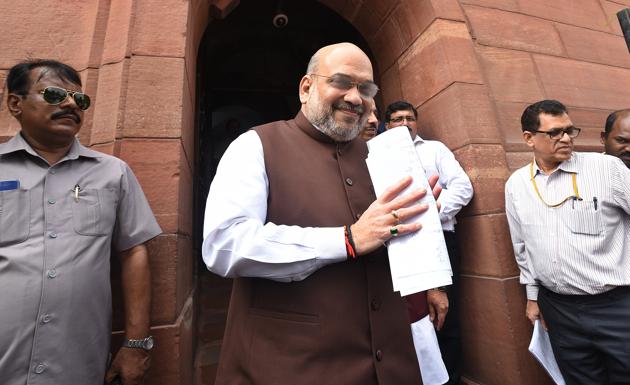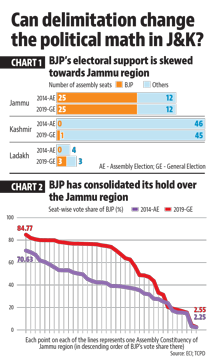The electoral impact of bifurcation of J&K
Will the proposed bifurcation of the state of Jammu and Kashmir into UTs of Jammu and Kashmir and Ladakh impact the electoral arithmetic of the region? Looking at the results of 2014 assembly elections and 2019 Lok Sabha elections can throw some light on the issue.
The Rajya Sabha on Monday cleared The Jammu and Kashmir Reorganisation Act, 2019 in the Rajya Sabha. The bill seeks to reconstitute the state of Jammu and Kashmir and create two union territories (UTs), Ladakh and Jammu and Kashmir. While Ladakh will not have an elected assembly, Jammu and Kashmir will function as a UT with an elected assembly, on the lines of Delhi and Puducherry. The Bill also provides for delimitation of parliamentary constituencies (PCs) and assembly constituencies (ACs) in the newly created UT of Jammu and Kashmir.

Will the proposed bifurcation of the state of Jammu and Kashmir into UTs of Jammu and Kashmir and Ladakh impact the electoral arithmetic of the region? Looking at the results of 2014 assembly elections and 2019 Lok Sabha elections can throw some light on the issue.
The Bharatiya Janata Party (BJP) won 25 ACs in Jammu and Kashmir in the 2014 assembly elections. The total strength of the Jammu and Kashmir state assembly is 87. There are another 24 ACs reserved for regions in Pakistan occupied Kashmir. In the 2019 Lok Sabha elections, the BJP had a lead in 29 ACs in the state. The BJP’s electoral success in Jammu and Kashmir has been regionally skewed in both 2014 and 2019. In both, it won 68% of the ACs in the Jammu region, which sends 37 out of the 87 members to the assembly. However, it drew a blank in the Ladakh and Kashmir regions in 2014, while it led in three out of four ACs in Ladakh and just one out of 46 ACs in the Kashmir region in 2019.
Also read: ‘Be ready’: Amit Shah’s phone call that began countdown to revoke Article 370

See Chart 1: Region-wise AC breakup in 2014 and 2019
With Ladakh carved out of what is proposed to be the new UT of Jammu and Kashmir, the BJP will have 25 MLAs in a house of 83 according to the 2014 assembly election results. Can redrawing of AC boundaries by delimitation change things?
HT has pointed in an earlier piece (https://bit.ly/2M0nqWA) that electoral outcomes in Jammu and Kashmir have been reflecting the religious polarisation in the state. BJP’s electoral success were from Hindu dominated regions in Jammu; 18 out of the BJP’s 25 seats in the 2014 assembly elections came from the four districts of Udhampur, Kathua, Samba and Jammu. These are also the only districts in the state where Hindus are in a majority.
Of the 20 districts which will comprise the proposed UT of Jammu and Kashmir, Hindus have a less than 5% population in 10 districts, all of which are in the Kashmir region. There are six districts in the Jammu region, where Hindus are not a majority unlike the four districts listed above, but their population share varies from 49% (Reasi) to 7% (Poonch). The BJP could win or lead in only seven and four ACs in these districts in 2014 assembly and 2019 Lok Sabha elections.
Also read: Jammu and Kashmir: Now a territory of the Union
If there were to be a calculated delimitation in this region, the BJP stands a chance to increase its tally. Here’s why.
In 2014, the BJP had a vote share of 50% or more in 12 ACs out of the 37 in the Jammu region. This number increased to 24 in the 2019 elections.
See Chart 2: BJP vote share in Jammu region in 2014 and 2019
The promise of abrogating Article 370 is likely to further consolidate the Hindu vote in Jammu in the BJP’s favour. If a delimitation exercise were to redraw AC boundaries in the Jammu region such that Hindu population increases in some of the non-Hindu majority ACs in the Jammu region, the BJP could gain in some of the 12 ACs which it was not been able to win in 2014 and 2019.
Another possibility is that the delimitation exercise reduces the number of seats in the Kashmir region, while it increases those in the Jammu region.
Article 370 revoked I Analysis I How Modi, Shah and Doval orchestrated move
To be sure, it might be the case that the government’s decisions regarding Jammu and Kashmir are driven by its larger politics rather than the electoral arithmetic in the state. However, the fact that delimitation has been made a part of the exercise, suggests that concerns for tilting the electoral arithmetic in the BJP’s favour cannot be ruled out.






